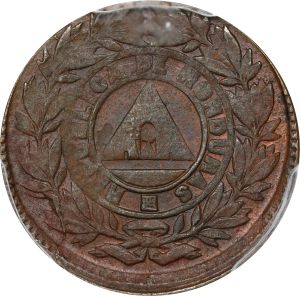Honduras 1910 centavo KM-67
The first specimen was lot 1850 in Classical Numismatic Group's auction of the Richard Lissner collection (Chicago, August 2014), where it sold for $133.10. The catalog description[1] noted, "HONDURAS, Republic. 1840-pres. Æ Centavo. Tegucicalpa mint. Dated 1910. In NGC encapsulation graded MS 64 BN. Dark brown with hints of red. Only specimen ever graded and extremely rare this choice. Purchased from M. Louis Teller, January 1979." This type is listed in the SCWC for 1910-11. Numerous varieties exist, depending on what dies were being reused to strike the coin. This type was struck using old five centavo dies; KM 65 was struck using recycled half centavo dies. In 1931, Honduras abandoned the peso, closed her mint and introduced the lempira, minted under contract in Philadelphia. The second specimen was lot 45387 in Stack's Bowers ANA sale (Oklahoma City, OK, August 2025), where it sold for $145. The catalog description[2] noted, "HONDURAS. Centavo, 1910. PCGS AU-58. Mule struck with altered 5 Centavos reverse die (KM-48)."
Recorded mintage: 410,000 (including KM 65 and KM 67).
Specification: 2.12 g, bronze, the first specimen Ø15 mm, 1.81 g, 6h axis.
Catalog reference: KM 67; Y 35.
- Michael, Thomas, and Tracy L. Schmidt, Standard Catalog of World Coins, 1901-2000, 47th ed., Iola, WI: Krause Publications, 2019.
- Raymond, Wayte, The Coins of Central America, Silver and Copper, 1824-1940, New York: Wayte Raymond Inc., 1941.
- Robinson, Charles, The Coins of Central America, 1733-1965, San Benito, TX: 1965.
- [1]Teller, M. Louis, and Victor England, Jr., The Richard Lissner Collection, Lancaster, PA: Classical Numismatic Group, 2014.
- [2]Orsini, Matt, Kyle Ponterio and Jeremy Bostwick, August 2025 Global Showcase Auction, World & Ancient Coins, featuring The Richard August Collection and the Richard Margolis Collection, Costa Mesa, CA: Stack's Bowers Galleries, Inc., 2025.
Link to:


